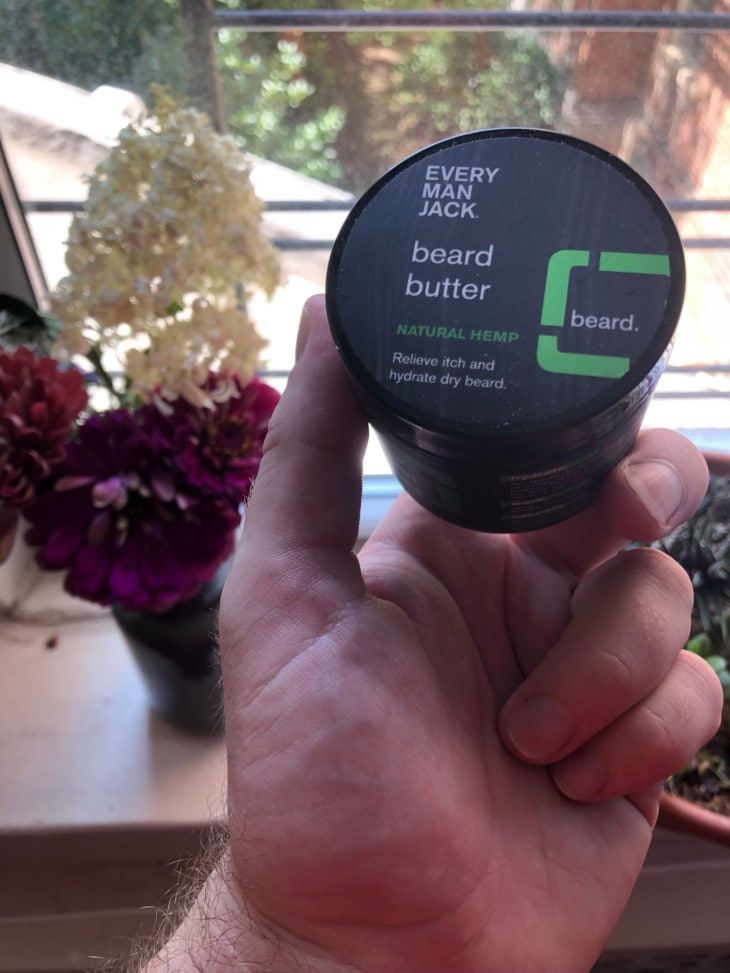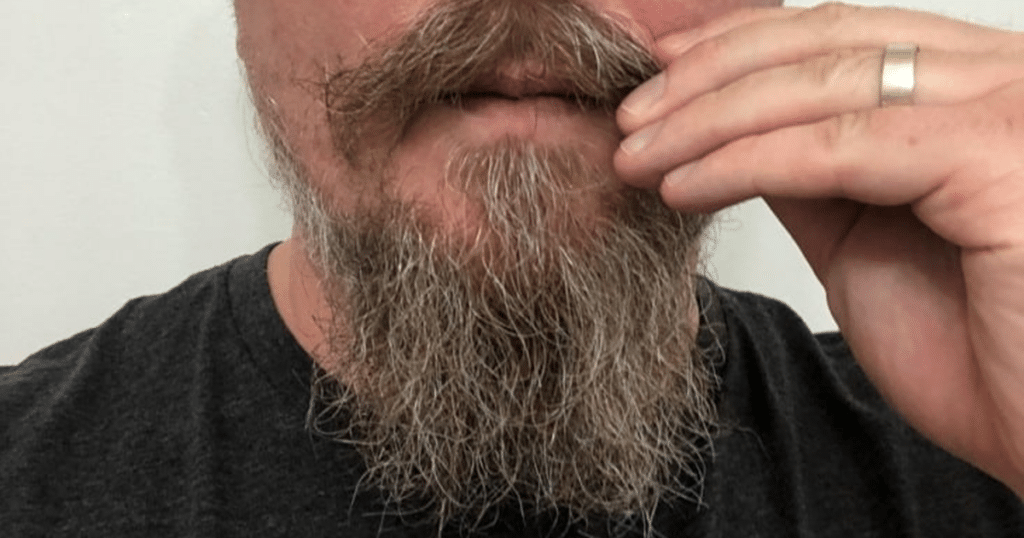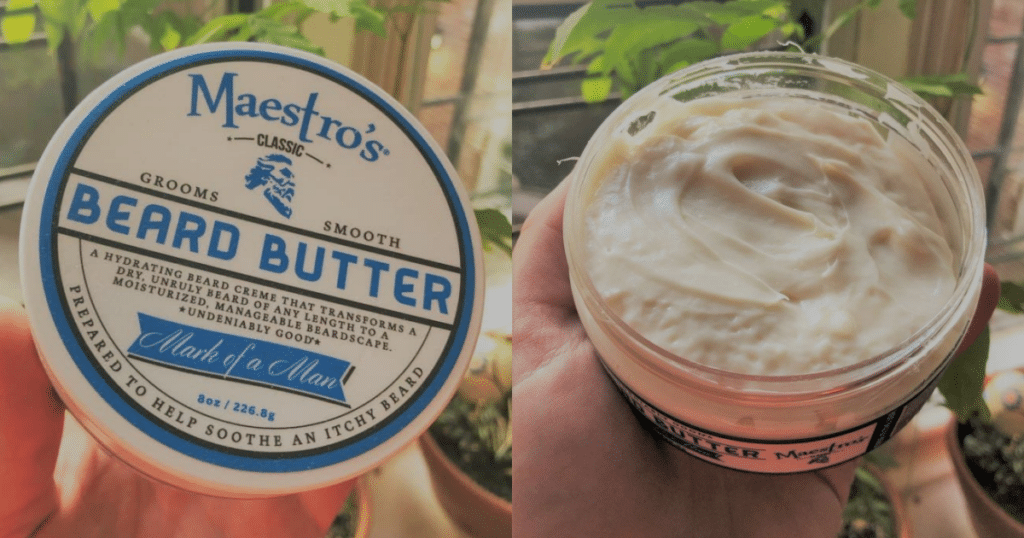Here, we’ll discuss Maestro’s Beard Butter. Does it deserve the name “Maestro”? Is it any good? Or is it a failure, undeserving of praise, to be shunned and forgotten?
Here, we’ll take a look. There’s a lot we like about it, and maybe one or two things we hope the Maestro works on.
We’ll start with an overview and then dive into the details, and provide some insight on exactly what a beard butter is, in case you’re not sure (and plenty of guys aren’t!).
SUMMARY: MAESTRO’S BEARD BUTTER REVIEW
Overall, very good. The main thing it’s got going for it is its hydration capabilities—a unique combination of oils and seed and nuts butters that join to moisturize beard hair and the skin on your cheeks, chin, and jaw. It’s got a very unique, and in our estimation, a very enticing, scent—grapefruit, pepper, and bergamot (which is a citrus)—that’s not too pushy or aggressive, and has a clean, aromatic smell. It’s not an all-natural formulation, so if that’s what you’re looking for, this probably ain’t it, and it can go quickly if you don’t use it conservatively. Overall, we consider this a great option if you’re looking for a hydrating butter with a mild and masculine-yet-not-overpowering scent.
OK! Let’s get into the details:
What May Delight You About Maestro’s
Here’s what we like:
It’s Creamy and Great for Hydration
Here’s perhaps our favorite thing about Maestro’s Beard Butter: it’s a great moisturizer. If you look at it in the jar, it actually kind of reminiscent of a skin cream used specifically for hair and skin hydration:
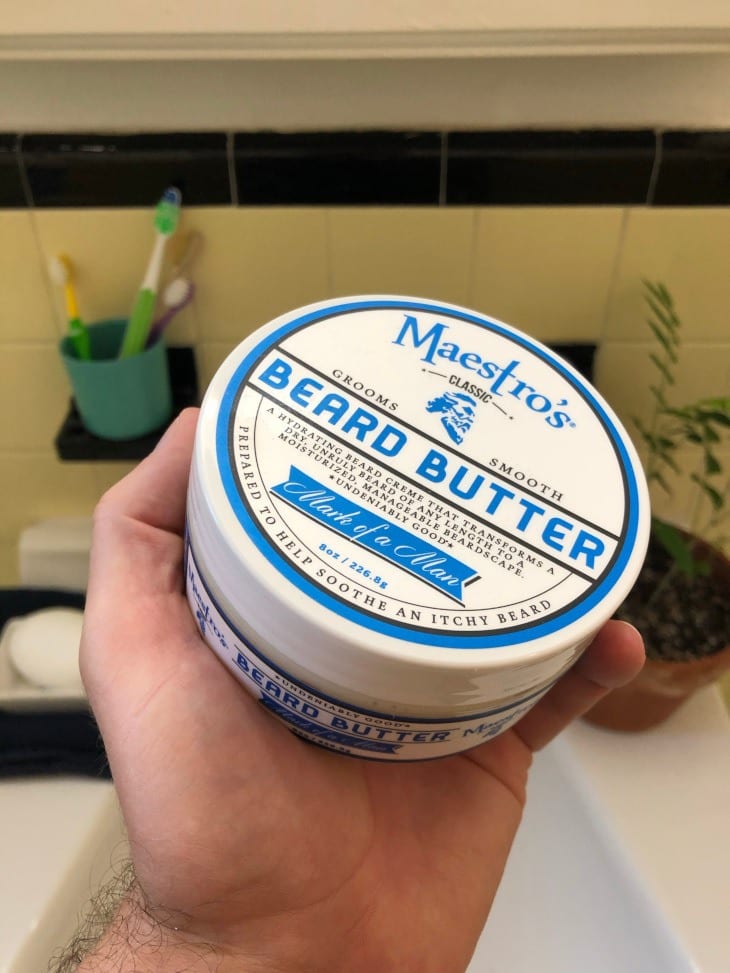
It smells very good (more on that in a moment), and it provides a little bit of body, but the real feature here is hydration.
That makes sense, too, because there’s a lot in the ingredient list included to treat hair and skin, including-but-not-limited-to:
coconut oil, castor seed oil, lanolin (great for moisturizing), shea butter, cocoa butter, wheat germ oil, grapefruit peel oil, pepper oil, and mulberry bark extract
In other words, a whole lot of oils and butters—all good for moisturizing beard hair and the dry skin that rests beneath it. There are a few things that aren’t fantastic (including alcohol, which is a bummer), but on the whole, there’s a lot to like.
All those ingredients are included to create a product designed to hydrate, meaning that Maestro can be a good option if you’re got a dry beard, dry skin underneath it, or experience beardruff/flaky skin. Your experience may vary, of course, but those ingredients are known to be very capable at combating those conditions.
It Smells Appealing, Like…?
If you ever want to engage in an exercise in futility, try running a website devoted to shaving and describing how shaving products smell. So many of the smells are absolutely unique and have scents that are utterly indescribable, and trying to convey what something smells like via the internet is nigh on impossible.
With that said…! here we go:
Maestro’s doesn’t have a specific smell, like many other beard products do (like lemon, or mint, or cedar, or whatever). Instead, it’s a blend of grapefruit, black pepper, and bergamot (bergamot is a citrus smell—a little sweet and a little tart). You’d think it would be very vibrant, overpowering, with ingredients like that, but it’s not—it’s actually really gentle and clean-smelling. It doesn’t smell like soap—that’s not what we’re saying when we mean it smells clean—but it has gentle, refreshing scent.
It’s actually interesting—the jar says that the scent is for “a classy black-tie experience.” That’s kind of a weird thing to say about a beard butter, and if we just heard it described that way without smelling it, we’d say that description is ridiculous—but it actually makes a lot of sense. It’s a quiet but pleasant scent, not overpowering but not absent. If cologne is something you’d want to smell like for a night out, this would be for a cocktail hour or wedding or something.
Obviously you can wear it for whatever you want, and our description is all conjecture. We’re just trying to express the idea that we find the scent appealing in a dignified, not-showy sort of way.

By the way, if the original scent doesn’t do it for you, there’s also Maestro’s Speakeasy Blend (which is a combination of tobacco and vanilla—such a great name for that scent), and Maestro’s Wisemen’s Blend (which is a blend of cypress, rosewood, and frankincense—a strong scent, and maybe a little complicated for some folks, but it has a lot of fans).
What May Displease You About Maestro’s
Overall, we think this is a great product—and a good option if you’re tired of beard oils and/or beard balms—but we dooooo have a few complaints, and they are:
The Ingredient List is Pretty Long and Maybe Not-So-Natural
We looked it up on the Maestro website, and the butter includes, among other things, Stearyl Alcohol, PEG-8 Dilaurate, Ceteareth-20, and Glyceryl Stearate” and “Acetylated Lanolin and PEG-100 Stearate.” If you’re looking for an all-natural formulation, this may not be it.
It’s Not a “Simple” Scent
Some guys seem like to like straight-forward, recognizable scents, like lemon or lime, cedar, or sandalwood, and this isn’t that—it’s a complicated scent that’s a little difficult to place. We like it a lot, but if you’re looking for a straight-up scent, you may want to check out Legend Beard Butter Sandalwood and Vanilla, which is a lot more recognizable. And, lastly…
It Tends to Go Quickly
That’s one disadvantage to beard butters—it can take a lot of it to really work into your beard and onto your skin. That’s more of a general criticism of beard butters than of Maestro’s Beard Butter, but it’s something to keep in mind. If you’re looking for a product that lasts longer because you use less of it, you may want to try and a beard balm, or even better, a
So there you have it! Those are the pros and cons, as we see them. With all that said, there are some other ideas we should mention in our Maestro’s Beard Butter review, and they include…
If You Are a Person Who is Extremely Cheap…
Earlier we talked about black tie events, but here we’ll take it down a notch, and talk penny-pinching: there’s, like, a little “bonus” dollop when you first use the butter, and we love that.
When you open it up, there should be a little bit of protective paper that you need to peel off the rim of the tub. Because beard butter is a little looser/creamier than balms and waxes, the butter itself has probably gotten jumbled up during shipping/transport, and there should be plenty of it on top of that protective paper.
If you’re a cheapskate, like I am, you can use that little bit—it’s easily a single serving. Bonus!
If You’re New to Beard Butter, Here’s What You Need to Know
The main people use beard butter is for its hydration properties. It doesn’t provide any hold—if you’re looking for hold, you’ll want a beard balm (or even better, a beard wax)—and its biggest advantage is its ability to moisturize both your beard hair and the skin beneath it.
Beard butter has a soft, creamy consistency, and it’s very easy to spread. It’s a sort of “middle of the road” product that exists between
It doesn’t feel like a butter, by the way—it’s called “beard butter” because the ingredient list usually includes one or more types of “butters” from nuts and/or seeds, like shea butter, mango butter, avocado butter, or cupuacu butter. There are actually a lot of different types of butters, and many of them are GREAT for skin and hair. What we call “butter”—the stuff you spread on your toast and pancakes—is actually just *a specific* butter.
Here’s what it looks like in your hands:
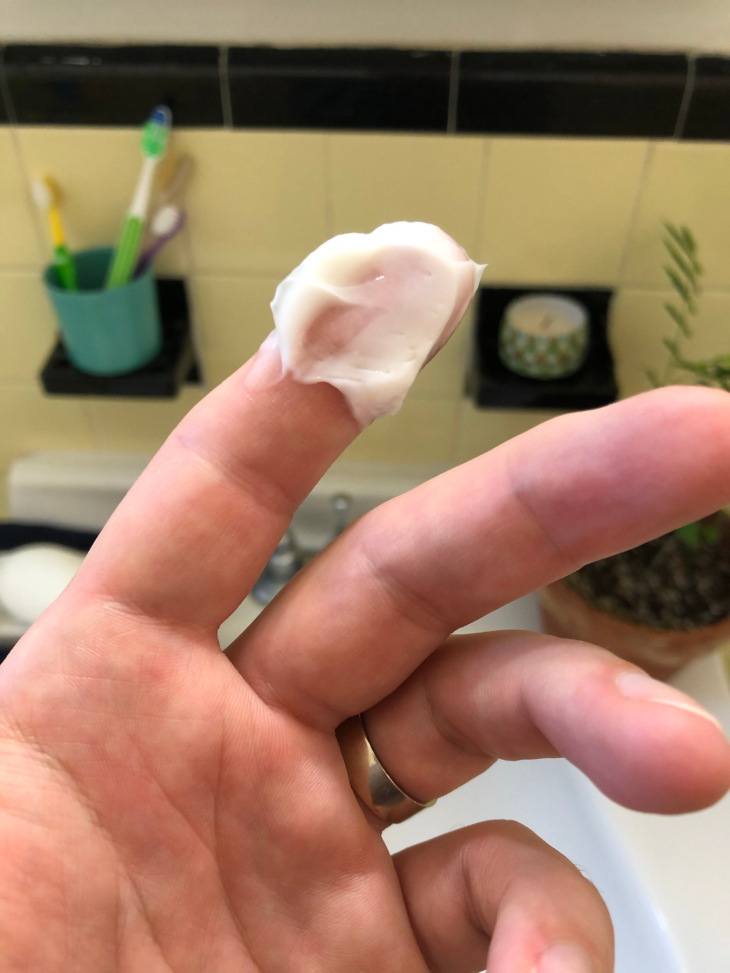
Mostly, beard butter gets compared to beard balm, because they’re both soft, easy-to-spread products that conditioner your beard and moisturize your skin. Beard balm also conditions and moisturizes, but it also provides a bit of hold—which beard oils and beard butters do not.
So, is it for you? Well, if you find that
If You’re Still Confused as to Which Product to Should Use…
If you’re confused about which you should try, here’s what we usually suggest. Keep in mind, the “ease of spreadability” goes from oils (easiest), to butters (a little more difficult), to balms (a little more difficult than that), and waxes (difficult).
> If you’ve got a short beard, beard oil or beard butter will usually do the trick, and it doesn’t matter which you use—it will most likely come down to a personal preference. Both
> If you’ve got a medium-length beard, you can use any of the three—beard oil, beard butter, or beard balm. Each will moisturize and hydrate—just keep in mind that an oil will be easiest to work into your beard and onto your skin, a butter will be a little bit harder, and a balm with be harder than that. If you’ve got fly-aways or want to style your beard a bit, go for beard balm—it can shape your beard a little bit better than a
> If you’ve got a long beard, chances are you want a beard butter or a beard balm. Longer beards tend to get unruly, and they need a little bit of taming, which butters can provide, and which balms can provide (even moreso).
Got all that? It seems like a lot, but it’s not too confusing once you understand what each product does.
Now for the curveballs:
> If you just want something that smells good, go for a
> If you really want to sculpt your beard, go for a beard wax. Beard does *not* moisturize your beard hair or skin—it’s solely for shaping.
> If you’ve got a thin beard, stay away from
> If you’ve got really oily skin, you may want to stay away from oils and butters, which are the easiest to rub onto your skin—and if you’ve naturally got oily skin, you probably don’t want more oil on it. A beard balm is probably best in that situation.
> If you’ve got really dry skin underneath your beard, beard butter can be a good option. Beard butter is a combination of oils and nut/seed butters, and both moisturize the skin—but because of its butter-y texture, beard butter can adhere to it and imbue it with hydration.
Get it? Got it? Good! Now you’re a pro.
Bravo, Maestro
We’re always curious how companies name themselves, and in the world of beard companies, you’ve got a lot of obvious choices: the word “Viking” is really popular, as is “Zeus,” and variations of the world “gentleman.” You’ll see a lot of that.
“Maestro” is a really interesting take, because it’s originally a term for a respected conductor or leader of musicians, but it’s eventually morphed to mean, roughly, “a distinguished man of great capability.” As in, “Whoa! Great work, Maestro!” Something like that.
We think the maestros at Maestro have done a good job here, making a butter that’s great at hydrating, and with a really unique-and-pleasing scent—we don’t know of any other grapefruit/pepper/bergamot mixes. All in all, a good option.
We hope that helps—good luck, have fun, and happy beard!
Michael Morris is the head writer here at Rough and Tumble Gentleman. He's got a ducktail beard and loves Brazilian jiu-jitsu. He's married to the woman of his dreams and lives in Brooklyn, NY.

